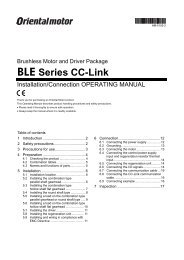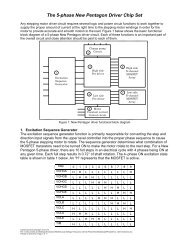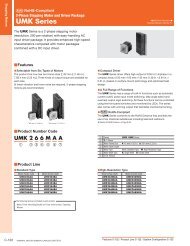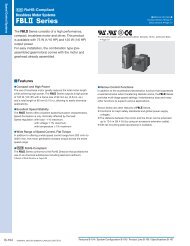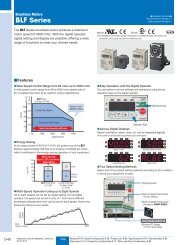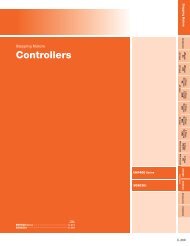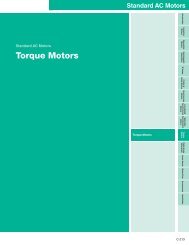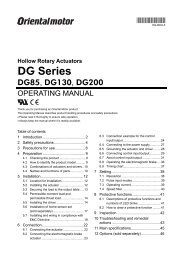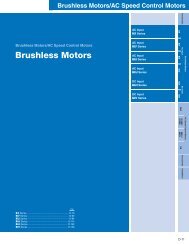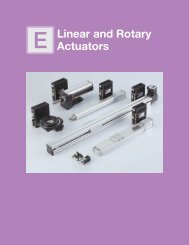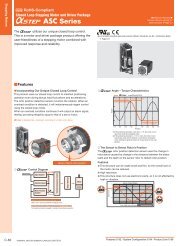Product Reference - Oriental Motor
Product Reference - Oriental Motor
Product Reference - Oriental Motor
Create successful ePaper yourself
Turn your PDF publications into a flip-book with our unique Google optimized e-Paper software.
Technical <strong>Reference</strong><br />
●Planetary ( PN) Gears<br />
◇Principle and Structure<br />
The planetary gear mechanism is comprised mainly of a sun gear,<br />
planetary gears and an internal tooth gear. The sun gear is installed<br />
on the central axis (in a single stage type, this is the motor shaft)<br />
surrounded by planetary gears enclosed in an internal tooth gear<br />
centered on the central axis. The revolution of planetary gears is<br />
translated into rotation of the output shaft via carriers.<br />
Internal Gear<br />
The upper gear eliminates backlash<br />
in the clockwise direction.<br />
The upper internal gear transmits<br />
torque in the clockwise direction.<br />
Upper Planetary Gear<br />
The lower gear eliminates backlash<br />
in the counterclockwise direction.<br />
The lower internal gear transmits<br />
torque in the counterclockwise direction.<br />
Upper Level<br />
Lower Planetary Gear<br />
Lower Level<br />
Sun Gear<br />
Carrier<br />
Planetary Gear<br />
Lower Planetary Gear<br />
Upper Planetary Gear<br />
Sun Gear<br />
Cross Section of a PN Gear<br />
Sun Gear:<br />
Planetary Gears:<br />
Internal Gear:<br />
A gear located in the center, functioning as an<br />
input shaft.<br />
Several external gears revolving around the sun<br />
gear. Each planetary gear is attached to the carrier,<br />
onto which the gear’s output shaft is securely fixed.<br />
A cylindrical gear affixed to the gearbox, having<br />
teeth on its inside diameter.<br />
The PN gear employs the planetary gear speed-reduction<br />
mechanism. The PN gear achieves the specified backlash of three<br />
arc minutes through the improved accuracy of its components and<br />
the backlash-elimination mechanism. That mechanism is comprised<br />
of two sets of internal and planetary gears on the upper and lower<br />
levels with the internal gear teeth twisted in the circumferential<br />
direction. The upper internal gears and planetary gears reduce<br />
clockwise backlash; the lower internal gears and planetary gears<br />
reduce counterclockwise backlash.<br />
Sun Gear<br />
Upper Planetary Gear<br />
Sun Gear<br />
Upper Planetary Gear<br />
Lower Planetary Gear<br />
Lower Internal Gear<br />
Upper Internal Gear<br />
Upper Level<br />
Relationship<br />
between upper<br />
and lower<br />
planetary gears<br />
Sun Gear<br />
Lower Planetary Gear<br />
Lower Level<br />
◇High Permissible Torque<br />
In conventional spur-gear speed reduction mechanisms, gears<br />
mesh one to one, so the amount of torque is limited by the strength<br />
of each single gear. On the other hand, in the planetary gear<br />
speed reduction mechanism, a greater amount of torque can be<br />
transmitted, since torque is distributed through dispersion via several<br />
planetary gears.<br />
The torque applied to each gear in the planetary gear speed<br />
reduction mechanism is obtained through the following formula:<br />
T: Torque applied to each planetary gear [N·m (oz-in)]<br />
T=k T'<br />
n<br />
T': Total torque transference [N·m (oz-in)]<br />
n: Number of planetary gears<br />
k: Dispersion coefficient<br />
The dispersion coefficient indicates how evenly the torque is<br />
dispersed among the individual planetary gears. The smaller the<br />
coefficient, the more evenly the torque is dispersed and the greater<br />
the amount of torque that can be transferred. To evenly distribute the<br />
transferred torque, each component must be accurately positioned.<br />
F-60 ORIENTAL MOTOR GENERAL CATALOG 2009/2010



